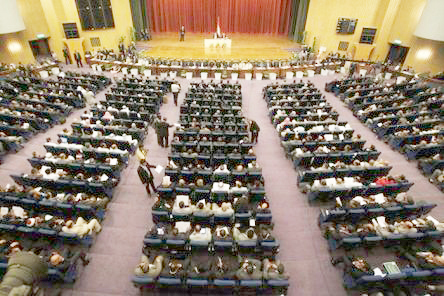She was carrying a wreath of flowers in one hand and a poster for the Socialist Party Alliance in the other. At first glance, with her cropped black hair and grey turtleneck sweater, she would have been hard to distinguish among the crowd.
Police streamed through the peaceful protesters in an attempt to disperse them. Sirens wailed; screams echoed. She had a five-year-old son, a husband, an entire life beyond the streets of Tahrir Square. But none of that mattered in the moment that bullets pierced through the wall of skin. An innocent woman falling into the arms of another protester. Shaimaa Al-Sabbagh was dead.
Her death, like many Egyptian fatalities in the 25 January Revolution that overthrew former president Hosni Mubarak, may well have just been another statistic splattered in a textbook, another brief printed on the bottom of a newspaper. Only it wasn’t. It was condemned, analysed, and criticised. It was acknowledged by President Abdel Fattah Al-Sisi on live television, where he called Al-Sabbagh his own daughter. It was lamented over and over until Al-Sabbagh—the unjustly taken poet, activist, and mother—became a symbol of Egyptian police cruelty. All this because someone was able to capture the event with a camera.
Fast forward to Baton Rouge, Louisiana, 2016. In another death that would go on to become an emblem of reformation, Alton Sterling was shot and killed by a police officer outside the convenience store where he sold CDs. Viral video footage of the encounter shows Sterling pinned down by two officers, a blur of limbs and screams and pleas, until a shot rings out that fades it all into silence. Sterling, a father of five, lays shaking on the floor as a pool of blood forms on his chest. The police officer was white and Sterling was black—it was not the first time the American public had witnessed an event like this. The next day, a young black man, Philando Castile, was shot in his car by an officer while his girlfriend filmed the ordeal. The silence didn’t last for long. An aftershock of movements against police violence would occur in Baton Rouge, New York City, Dallas, and other cities throughout the country. It was at one of these protests in Dallas that five police officers were brutally murdered, sparking even more public outrage.
When we hear of one death, it becomes engraved in our minds as a tragedy, often more so than when we hear of a multitude of deaths. This phenomenon is referred to as the “identifiable victim effect”. It states that we need to see someone as an individual, not a number, in order to relate to them. That’s how we empathise. That’s how we are pushed to fight.
Take the Syrian humanitarian crisis, which for years was only lightly brushed upon in most Western news outlets, until a photo of three-year-old Aylan Kurdi’s drowned body surfaced on the internet. The more than 200,000 Syrian deaths were condensed into one sentence, but the death of Kurdi after his family tried to escape Syria was worth thousands. Afterwards, the refugee crisis stole most headlines, fuelling the political debate over what to do with Syrian refugees in Europe and America.
“There’s a reason the media points out whether a person was a father, mother, or brother—it makes them more relatable,” said Dr. Saneya H. Tawfik, a psychologist and the director of the psychological services centre at the University of Miami. “If you were to hear about someone who died in the middle of the Amazon who was unconnected to anything, it’s hard to have empathy. You need someone you can relate to based on race or religion so that you can have a bond with them.”
In a 2013 study by Slovic and his associates, the identifiable victim effect was tested by seeing which factors would impact a participant’s decision to donate money to orphans. They were placed in an MRI scanner and either told the name of an orphan, shown his/her silhouette, or shown a picture. The researchers concluded that the subjects were more likely to help the orphan whose image they saw, a concept groups like Children International implement when they send people yearly pictures of the orphans they sponsor.
Occurrences all over the world demonstrate the power that a video or picture can possess. Despite the potential embedded in that notion, it comes with drawbacks. Reducing reality to a state of two dimensionality strips it of its scale. Grand issues can become distorted and drained, complex situations symbolised by just one story. Such images can cause us to live in an optical illusion where our perspective is only defined by what we see, not what occurs in the background. It is then our responsibility to not become desensitised to the unseen tragedies occurring worldwide, and to create our own objective lens to look through.
Sometimes it’s the things that can’t be captured with a camera that matter most.


